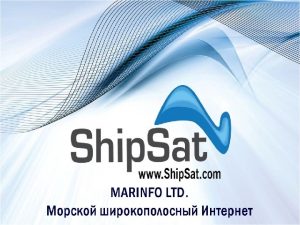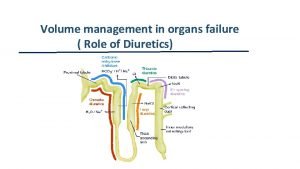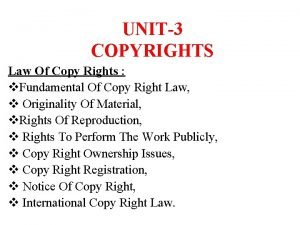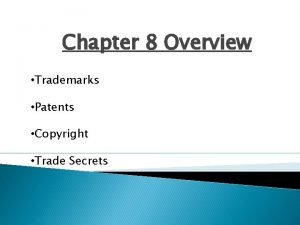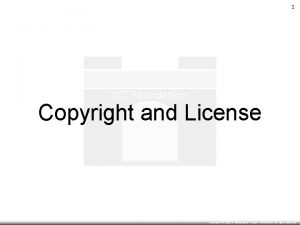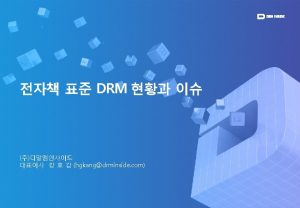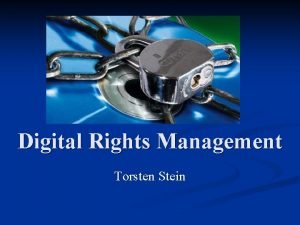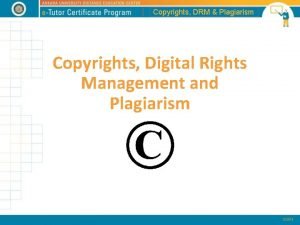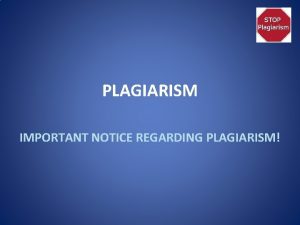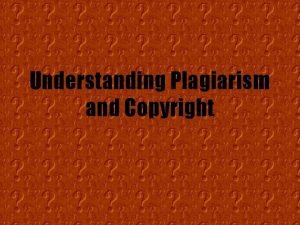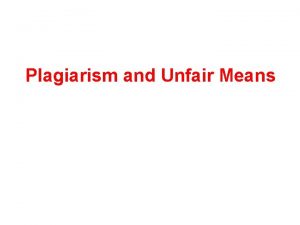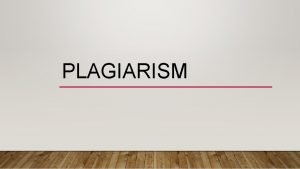Copyrights DRM Plagiarism Copyrights Digital Rights Management and










- Slides: 10

Copyrights, DRM & Plagiarism Copyrights, Digital Rights Management and Plagiarism

Copyrights, DRM & Plagiarism Copyright • Copyright does not protect the ideas, but protects the way used to present these ideas. There are two important purposes of copyright: personal and social. • Personal copyright is to award and encourage those who create, produce or design works via copyright, so as to allow them to create more. • Social copyright, on the other hand, is to provide access to original and innovative works by everybody after a certain period of time (Tonta, 2003).

Copyrights, DRM & Plagiarism Copyright • Instructors may want to use some parts of books, original articles, images found on the web etc. in their e -course content. • When such materials are used for academic and educational purposes, there is a certain amount of freedom in terms of copyrights. • Audio and visual materials are allowed to be used in face-to-face learning environments. • In the e-learning process, on the other hand, photos, maps, cartoons and other printed materials can only be used with the condition that they are not used in the same order with the copyrighted programme (Simonson, Smaldino, Albright & Zvacek, 2003).

Copyrights, DRM & Plagiarism Intellectual Rights • Nowadays, intellectual rights are considered as a bridge between technology, economics and commerce. • Intellectual rights, in general, are rights on such products as trademarks, patents, works, production and publications. • Regulations about the intellectual rights are for the benefits of society. • Studies on intellectual property are globally carried out by World Intellectual Property Organization (WIPO).

Copyrights, DRM & Plagiarism Digital Rights Management • Digital Rights Management (DRM) has been developed to take license rights of digital media (e. g. movies, music) under control since it is very easy to copy and use such media without permission. • DRM is a technology used to control the use and distribution of digital products you can buy from online stores such as songs, albums, movies, software or games. • It works on the basis of encryption and other similar computer technologies.

Copyrights, DRM & Plagiarism Creative Commons • Creative Commons’ free, easy-to-use copyright licenses provide a simple, standardized yet unusual way to give public permission to share and use creative work of others on certain conditions determined by themselves. • Supporting the non-commercial use of works, Creative Common licenses have taken a big step from traditional concept of “all rights reserved” to “some rights reserved” (creativecommons. org).

Copyrights, DRM & Plagiarism Academic Ethics and Plagiarism • Cheating and plagiarism by students used to be easily spotted before the widespread use of the Internet when they could not reach ‘offthe-shelf’ homework on the web. • As mentioned by Kökdemir (2003), American Psychological Association (http: //www. apa. org) offers some suggestions to educators about this subject: 1. Give information to your students about plagiarism. Although it is a slight possibility, some students do not know that plagiarism is unethical. 2. Apply clear sanctions in case of plagiarism. In most universities, students that commit plagiarism fail the class, even though they fulfil all other criteria to pass. 3. Limit the resources. Instead of saying “you can find information wherever you want”, guide them to use specific books, journals or websites while doing their homework. This is an important approach for preventing internet plagiarism. 4. Check their homework for real.

Copyrights, DRM & Plagiarism Academic Ethics and Plagiarism Straight plagiarism Plagiarism using a citation Selfplagiarism Plagiarism Simple plagiarism using a footnote Paraphrasing as plagiarism Plagiarism with hanging quotations Complex plagiarism using a footnote

Copyrights, DRM & Plagiarism Academic Ethics and Plagiarism • There are software programmes for detecting plagiarism, which give detailed information about the degree of plagiarism in a text. Turnitin, Ithenticate and search engines like Google are among commonly used plagiarism software.

Copyrights, DRM & Plagiarism Conclusion • Cheating on the Internet is very easy, so it is tempting for students. • We should inform our students about copyright as well as ethical issues. • As instructors, we can also use plagiarism detection software to reveal unwanted attempts, and to make learners aware of what they are really doing.
